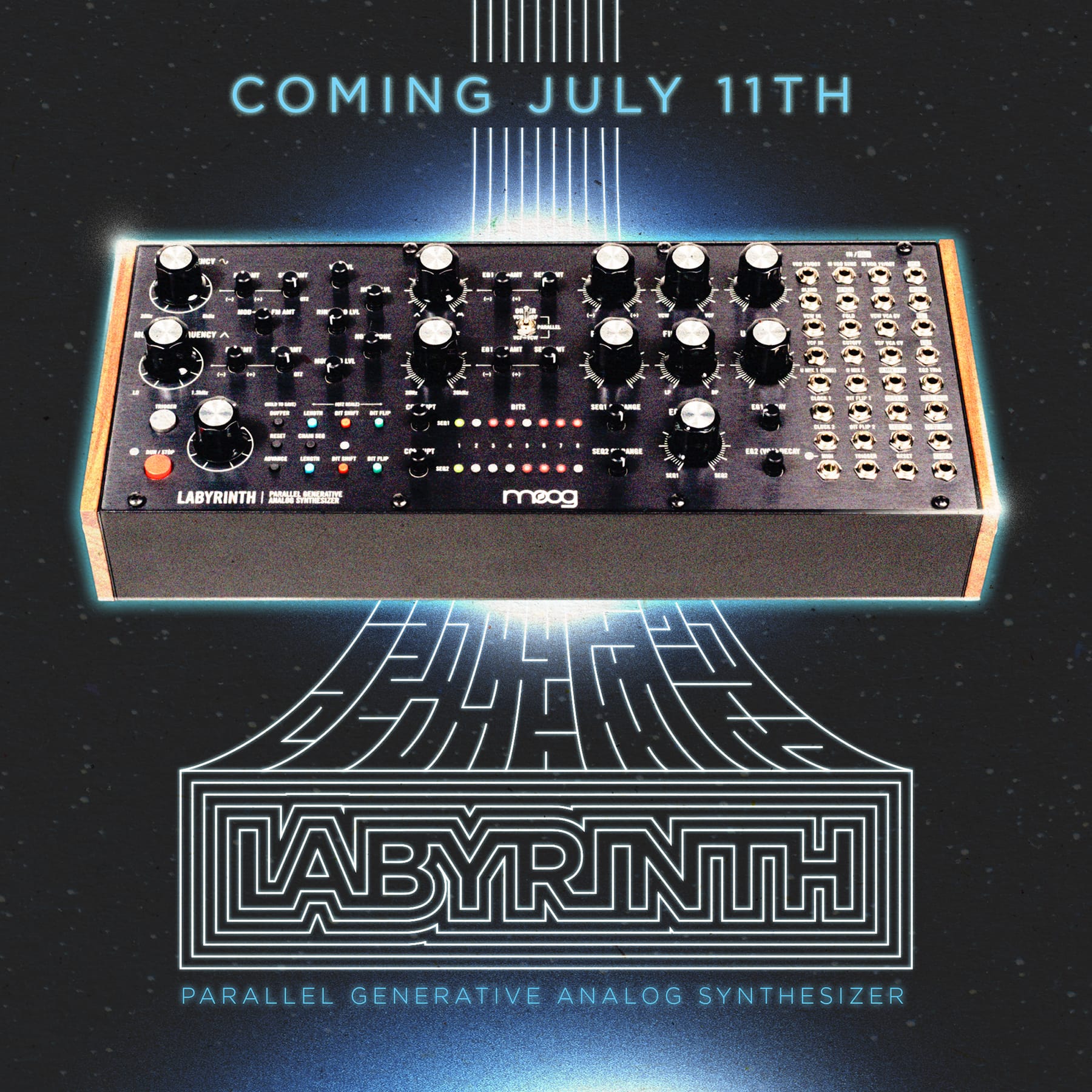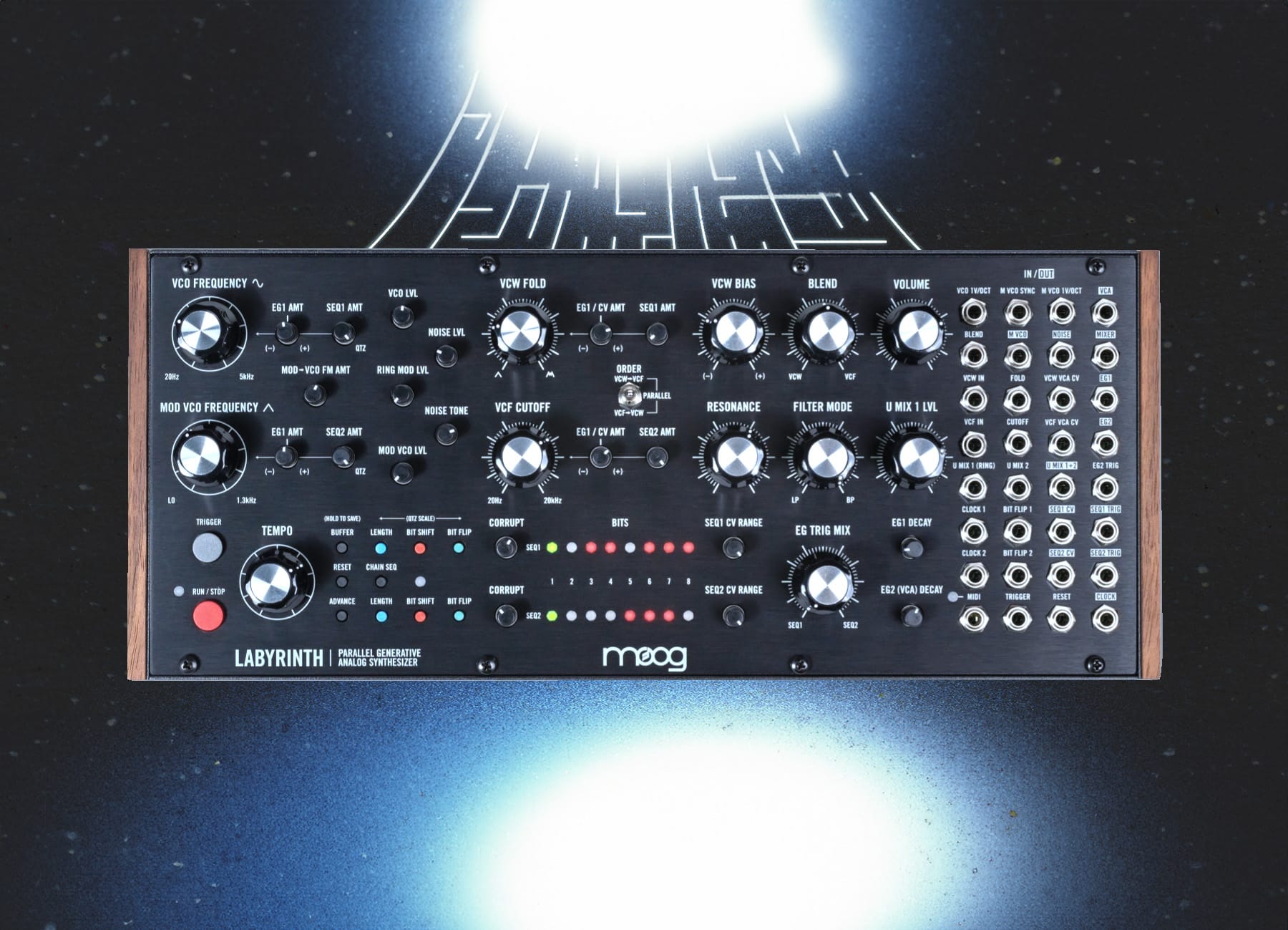A semi-modular synth with a West Coast twist
Moog has long been synonymous with East Coast synthesis, characterized by its subtractive synthesis approach and signature warm, analog sounds. However, Moog's latest offering, the Labyrinth, ventures into uncharted territory with a bold embrace of West Coast synthesis. The Labyrinth is a parallel generative analog synthesizer that merges Moog's classic design with innovative features inspired by the likes of Buchla and Serge synthesizers. Here's an in-depth look at what makes the Labyrinth a groundbreaking addition to the Moog family.

- West Coast synthesis approach
Incorporates frequency modulation (FM), ring modulation, and wave folding. - Oscillators and modulation
Features two VCOs—sine wave and triangle wave, with both exponential and linear FM. - Versatile envelopes and VCA
Simple decay knob for the VCA; pitch envelope can be inverted. - Saturation and noise
Built-in saturation and a noise generator with color options (brown to pink to white). - Wave folding and filtering
Includes a wave folder and a band-pass filter, with configurable order. - Parallel and serial processing
Signal path can be set in serial or parallel modes; controlled by a blend knob. - Advanced sequencing
Innovative sequencer with an analog shift register concept; sequences can be randomized and saved.
A West Coast Synthesis approach
Unlike traditional Moog synthesizers, the Labyrinth incorporates elements commonly found in West Coast synthesis, such as frequency modulation (FM), ring modulation, and wave folding. This synthesis approach offers a vast range of sonic possibilities, making the Labyrinth capable of producing everything from rich, complex textures to stark, otherworldly tones.

Oscillators and modulation
The Labyrinth features two primary voltage-controlled oscillators (VCOs). The first VCO is a sine wave oscillator that serves as the main sound source. Users can adjust its pitch using a simple decay envelope and control its pitch sequences through CV inputs. The second VCO operates as a triangle wave, responding to a secondary sequencer.
One of the standout features is the inclusion of both exponential and linear FM, providing a broad palette of modulation options. Exponential FM is typically associated with analog synthesis, while linear FM is more commonly found in Yamaha's digital synthesizers. Combining both types of FM allows for incredibly diverse and intricate soundscapes.
Versatile envelopes and VCA
The Labyrinth is equipped with straightforward yet powerful envelopes. The VCA features a single decay knob, which ranges from ultra-fast to relatively long decay times, allowing for dynamic shaping of the sound. Additionally, the pitch envelope can be inverted, adding another layer of modulation complexity.
Saturation and noise
A notable characteristic of the Labyrinth is the inherent saturation present in its circuitry. Even with just a sine wave, users can achieve a rich, saturated sound, adding warmth and character to the signal. The synthesizer also includes a noise generator with a color knob, offering a spectrum from brown to pink to white noise.
Wave folding and filtering
One of the Labyrinth's most exciting features is its wave folder, which can be placed before or after the filter using a simple switch. The wave folder can be modulated by an envelope and a bias knob, providing deep control over the timbral shaping of the sound. Additionally, the filter section includes a band-pass filter, a first for a Moog synthesizer, further expanding the sonic versatility.
Parallel and serial processing
Users can configure the signal path in either serial or parallel modes, allowing for unique combinations of wave folding and filtering. This flexibility is controlled by a blend knob, which adjusts the balance between the two processing paths.
Advanced sequencing
The Labyrinth features an innovative sequencer based on the concept of an analog shift register. Users can toggle bits on and off, shift them, and control the sequence length, creating evolving, generative patterns. A prep knob allows users to randomize sequences until they find something they like, which can then be saved and chained together.
Labyrinth demo from Jan Juno
A new chapter for Moog
The Moog Labyrinth marks a significant milestone for the company following its recent acquisition. This pioneering instrument bridges the gap between East and West Coast synthesis philosophies, showcasing Moog's shift in design approach.
With its robust modulation capabilities, unique wave folding and filtering options, and advanced sequencing, the Labyrinth offers new possibilities for sonic exploration. The official release date is set for July 11th, sparking anticipation within the synth community.
If this is the direction the new Moog is heading, it will be interesting to see how the company balances innovation with its established legacy.





